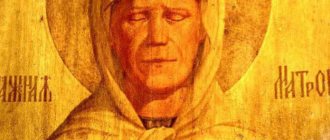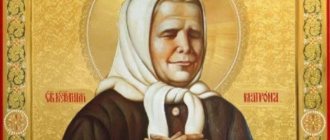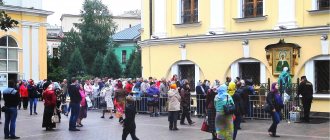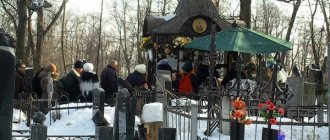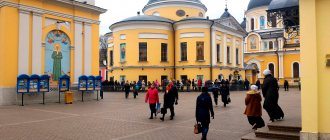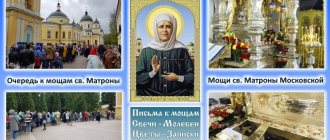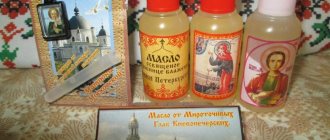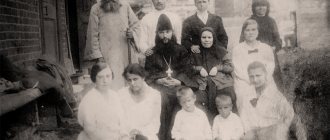Throughout church history, there are cases where not only priests or hermits, but also ordinary people who lived among the laity and healed those in need with the help of prayer, became miracle workers and healers. The holy blessed Matrona of Moscow is considered a similar righteous woman. She is revered as one of the most famous Orthodox righteous women. What to do with a flower from Matrona of Moscow? You will learn about this after reading the article.
Who is Mother Matrona?
She received her miraculous gift from the moment of birth. Even during her lifetime, she was well known as an ascetic who heroically took on hard work and hardships for the glory of God and in the name of love for people and helping them in need and illness. With her fate, she showed an example of the greatest spiritual feat of patience, self-sacrifice, mercy and humanity.
According to the memoirs of contemporaries, Mother was clear, radiant, enlightened, and had a humble, gentle voice.
Near her home there were always crowds of wanderers and pilgrims in need of support and consolation. They came to her from afar with their pains and sorrows. The blessed one did not drive anyone away, she helped everyone: she treated, consoled, and taught. And she did it for free. She only insisted on one thing - to believe in God. She taught me not to give up in difficult situations, to try to improve, to renounce a sinful life, and to repent.
No less pilgrims are drawn today to the burial place of Matronushka, as pilgrims affectionately call her, in the Intercession Convent. Whole families with children come here. Everyone comes with flowers. Mother loved any fresh flowers very much.
What flowers did Matrona of Moscow love?
Every day, hundreds of visitors visit the grave of the Holy Blessed Matrona of Moscow to share their troubles, ask for help, and express gratitude. They don’t come empty-handed, everyone brings her flowers. Lots of flowers, because she loved them very much during her life. Continues to love now.
It is impossible to say exactly what kind of flowers the blessed old lady Matrona of Moscow loved. Snow-white and yellow roses are often brought. They are sold in a shop near the entrance to the monastery. There are also carnations, chrysanthemums, daisies, peonies, tulips - depending on the season. In fact, Matrona loved a variety of flowers, and was especially happy with simple wildflowers.
You shouldn’t wonder what flowers Matrona of Moscow loved. For her, it didn’t matter what varieties and shades, it was important that they were brought lovingly, carefully, and sincerely. Bouquets are usually placed in vases next to her icon, or brought to the temple where her relics are kept.
How to ask for help and intercession from a saint?
It is believed that Matrona of Moscow patronizes people whose profession is related to the upbringing and education of children. Also under its protection are doctors, especially pediatricians, ophthalmologists, and orthopedists. Favorite holy month is May. It is believed that people born then can count on her help.
There are several ways to earn the favor of the Matrona of Moscow. The first of them is to feed the beggars on the street or stray dogs or pigeons. Before turning to the saint, it is good to bring a donation to the temple, including black bread, nuts, milk, cookies, honey, caramel.
However, the most important thing is to go to the monastery with bright intentions and a pure soul, with sincere faith and respect. After all, Saint Matrona never refused people help and consolation.
The miraculous power of Mother Matrona's flowers
In the will of Blessed Matrona there was a wish to visit her grave with flowers in order to tell her her sorrows.
They say that all the buds that were brought to the relics of the blessed one and stayed there for some time have special healing powers. The miraculous flowers of Matrona of Moscow can not only treat diseases, but also suggest a way out of a difficult situation and change it for the better. Many such stories are not only passed on from mouth to mouth, but are also published in books about the miracles of the righteous. Even flowers that are usually not stored for a long time, when taken from Matrona, may not wither for more than a month.
Where did the tradition come from?
She lived a difficult life, full of persecution, hunger and cold, but until the last hour she continued to serve people, being a conduit between God and Christians. Not only ordinary people, but also the powers that be, including rulers and generals, turned to the saint for help in moments of special problems, including diseases incurable by doctors.
Before her death, Matrona of Moscow said that at first rarely would anyone come to her grave, and then the pilgrimage would begin, and for every person who asked for her relics, she would ask before the Almighty.
Preparing to meet Saint Matronushka at her icon with her relics, believers try not only to explain their problems to the mother, but to please her with her favorite flowers.
Important! Bouquets brought to the blessed Matronushka are not a sign of her appeasement, but a symbol of the expression of love, veneration and gratitude.
Childishly devoted to God, never having seen the light, born with empty eye sockets, Matrona of Moscow loved flowers very much.
Standing in prayer near the icon of Matronushka, you feel amazing warmth and acceptance, tears themselves begin to flow. One gets the feeling that the holy prophetess is standing nearby. My soul becomes especially calm, as if the answer has come that everything will be fine.
Flowers of the Matrona of Moscow - consecrated flower bouquets, handed to everyone who comes out after veneration at the holy relics, have healing powers with faith in the power of the Creator and His saints.
It is difficult for the earthly mind to comprehend how a blind person can not only identify flowers, but also have special favorites among them.
What to do with a flower from Matrona of Moscow?
Flowers brought to mother remain for some time in the temple or at the icon. As they leave, the monastic workers give everyone who bows down to the saint’s relics a rosebud and a shoot of another flower, which were brought earlier and had already been in the monastery for some time.
What to do with a flower from Matrona of Moscow? A rosebud can be taken petal by petal, brewed into tea and drunk. The shoots should be applied to the sore spots until the pain goes away.
What else to do with a flower from Matrona of Moscow? Flowers received at the monastery are treated differently. They are placed in a vase and dried. It doesn't matter. The important thing is that the miraculous flowers of Matrona Moskovka retain their healing power for a whole year. The buds can be placed near the icon. Healing from the petals of the blessed Matrona will occur if you add them to tea. You can also take a bath with these petals.
What else to do with the flowers of Matrona of Moscow? They can simply be applied to sore spots. The pain will subside, and the long-awaited healing will come. What to do with used flowers from Matrona of Moscow? Under no circumstances should they be thrown into the trash. As a last resort, you can simply lay them on the ground. Knowing what to do with a flower bud from Matronushka, you will definitely be healed. The main thing is that the faith in your heart was real, sincere and strong.
Information site about icons, prayers, Orthodox traditions.
"Save me, God!". Thank you for visiting our website, before you start studying the information, please subscribe to our Orthodox community on Instagram, Lord, Save and Preserve † - https://www.instagram.com/spasi.gospodi/. The community has more than 60,000 subscribers.
There are many of us like-minded people and we are growing quickly, we post prayers, sayings of saints, prayer requests, and timely post useful information about holidays and Orthodox events. Subscribe. Guardian Angel to you!
Mother Matrona is a great saint who gave the entire Orthodox world eternal faith in miracles. Stories and legends are written about her to this day, and in front of the temple where her relics are located, there are always huge queues of people seeking help and advice in difficult and sometimes almost hopeless life situations. And they go to the blessed one with large bouquets of flowers, which she loved so much during her life, in order to show their affection, honest intentions and disposition. This decoration has its own special power and purpose. And therefore you can often hear the question: “What to do with the flowers that were given in the temple of Matrona?” The answer is further in the article.
Matrona's childhood
Matrona Nikonova was born in 1881. Her homeland is the village of Sebino, Tula province. Being the fourth and youngest child in a poor peasant family, she was born blind. Her parents, having learned about this, wanted to give her to a shelter. But the mother saw a prophetic dream, as a white bird of extraordinary beauty landed on her chest. True, the bird’s eyes were closed... The mother changed her mind: it happens that sick children are loved even more than healthy ones.
Children were sometimes cruel to the unhealthy girl and offended her. Matryona was not offended by them, she consoled herself with prayer, often went to church, and at home at night she played with icons and talked to them. The girl had another unusual symbol of chosenness - a three-dimensional image of a cross on her chest, a miraculous pectoral cross, which, according to her, was given to her by Nikolai Ugodnik.
It soon became clear that the unusual child had unique inner vision. From the age of seven, the girl knew how to predict and heal the sick. The news that this little girl’s prayers heal and console in sorrows and suffering quickly spread throughout the surrounding area. People began to come for help and, in gratitude, gave the girl’s parents provisions. So the blind child became not a burden, but a breadwinner for his family.
Youth Trials
In her adolescence, Matrona had the opportunity to travel to sacred places. The daughter of a neighboring landowner, a sincere and deeply religious girl, invited the blind girl on pilgrimage trips - to the Kiev-Pechersk Lavra, the Trinity-Sergius Lavra, to St. Petersburg with its grandiose cathedrals. There is a legend about a meeting in Matrona with John of Kronstadt, who somehow learned about her arrival at the cathedral and called her his successor, the eighth pillar of Russia. Most likely, Father John knew that Matrona would have a special service to her people in difficult times of persecution of Orthodoxy.
At the age of 17, Matrona suffered the following test: her legs gave out. For the rest of her life—50 years—she could no longer move independently. She foresaw this event and did not resist God's will. There were always volunteer helpers nearby. All the troubles of life did not make Matrona despondent and complain; she believed that everything was God’s will, and continued to carry out her service.
Flowers have meaning until they turn into a fetish
Archpriest Dimitry Klimov
Archpriest Dimitry Klimov
If people come up to me and ask for my blessing to take “flowers” or “countries” from a pilgrimage trip, I answer according to the situation. If I see that a person already has some understanding of church life, I bless him, but I say that he can do without it. But it happens that a person first thought about Orthodoxy when a shaman or healer sent him “to get oil.”
On the one hand, this is all really magic and witchcraft. On the other hand, people might not have remembered God without this. Maybe if a person has already approached the priest with a question, this will be some kind of clue.
In general, the question is not even whether the desire to bring consecrated objects is magical or not, but in the pettiness, in the fussiness of our religious life. In the unwillingness to understand something main, important, in the desire to pay attention to some peripheral things that are completely unrelated to the main thing. This pettiness is now characteristic of very many people, when a person does not separate the essential from the secondary.
One day a woman came up to me and began to talk about her visions, dreams, and how saints appeared to her. Seeing my skeptical expression, she asked, “Don’t you believe me?” I replied: “Why should I believe you?” To which I heard: “Well, you believe that Christ rose from the dead.”
And how can I explain to her that believing in God is one thing, but believing in all sorts of “sacred things” is completely different. A person should consider himself Orthodox when he has assimilated the Creed, the basic dogmas of our Orthodox Christianity. And not when he travels and brings flowers and land from everywhere.
It often happens that people ask about them when they have already returned. “Now what should we do with all this?” This question literally drives me into a stupor. You didn’t send the person anywhere and didn’t recommend going there, but he asks you what to do. Do what you want. Sometimes it comes to the point that they insist on drinking water and then drink it.
Our religious life is very much infected with this dense folk occultism. And all this is spread by those same “healing grandmothers” who have two diagnoses for all cases: damage and the evil eye. Unfortunately, this has also taken root in our church life.
I also have a big question for those monasteries where they distribute “shrines,” and sometimes it seems that their goal is simply to attract more people. It doesn’t even matter why they are going.
Miracle-working icons of the Matrona of Moscow
Once Matronushka turned to her mother with a request to tell the clergyman that in his library there was a book with the image of the Mother of God “Recovery of the Lost.” He was very surprised. The icon was indeed found. Matrona decided that she should order the same. According to her, the icon asked to come to their church. There was no money to create the image; it was collected from parishioners of many villages. Matrona showed insight here too: to those who gave reluctantly, she returned their contribution.
She advised the artist who began painting the icon to perform the necessary church sacraments before starting work. Nothing worked until he complied with her demand.
Work on the icon ended in 1915. She accompanied Matronushka all her life. Now it is kept in the Pokrovsky Monastery. With the blessing of the saint, funds were collected from villages for another icon, which is now kept in Novomoskovsk. The finished icon was carried in a religious procession all the way to Sebin. The matron was led arm in arm to meet the image 4 km away. And she anticipated the approach of the shrine to the minute. The icon “Recovery of the Lost,” famous for its many miracles, was revered in mother’s homeland.
Despite her unsettled life and wandering lifestyle, where Matrona lived for a particularly long time, many icons hung on the walls. And in the church where she went, she remembered all the icons by heart.
The beginning of the wandering
Matrona predicted a revolution as a child. She said that there would be murders, robberies, destruction of churches, persecutions. With the help of symbols, she communicated that first everyone would seize the land and then abandon it. Matrona gave advice to the neighboring landowner to sell his estate and go abroad. He didn’t listen to her, but in vain...
Indeed, after the October Revolution, Russian villages and villages were devastated and destroyed. Their residents, in order to feed themselves, began to look for work in the cities. Matrona, following her family, moved to Moscow in 1925.
Matronushkin's brothers, following the trends of the times, became members of the party. They were afraid of reprisals from the authorities because of the presence in their house of a healer and fortune teller, to whom people regularly came, and she taught them the Orthodox faith. Realizing this, feeling sorry for her elderly parents, Matrona leaves her home, changes apartments and basements.
Persecution and Persecution
She lives without registration, almost in an illegal situation, is afraid and miraculously avoids arrest. Sometimes she had to live with people who were hostile to her, often in terrible conditions. But there were also those who helped the blind, immobilized healer.
Sometimes Matrona had to urgently leave her habitable home literally a few hours before the police arrived. She felt them and saved from repression not so much herself as those who gave her shelter. They tried to arrest her many times. Many of her inner circle were imprisoned.
Memory of Blessed Matrona
She helped people with her unusual abilities until her last days.
The healer died on May 2, 1952. She was buried on May 4 in the presence of a huge number of people, at her request, at the Danilovsky cemetery. She dreamed of listening to the church service of one of the few churches operating in Moscow.
Long before her death, the holy blessed Matrona, guardian of holiness, prophetically predicted her future fate. Later this was confirmed. Mother understood that her grave would be abandoned and forgotten for some time, but after many years people would understand that she would be able to help them posthumously, and they would come to her for support. And so it happened. Now the flow of people in need of her support continues to come to her grave.
In 1998, the relics of Blessed Matrona were transferred to the Intercession Monastery, and in 1999 she was canonized.
Magism does not mean that everything should be banned
Archpriest Maxim Pervozvansky
Archpriest Maxim Pervozvansky. Photo by Yulia Makoveychuk
Magic happens when we think that through some objects or artifacts we will receive what we ask for. But this does not mean that everything should be banned.
Recently, on the first Sunday of Great Lent, we celebrated the Feast of the Triumph of Orthodoxy. This is also a victory over iconoclasm, which the veneration of icons declared magic. There were certain reasons for the emergence of iconoclasm, as now. Then they removed the paint from the icons, considering it medicinal. Now this is sand, which is taken from the grave of an old man, flowers from the blessed Matrona - certain material objects to which healing and beneficial powers are assigned.
The VII Ecumenical Council, approving the veneration of icons, explained that when we venerate images, we transfer our veneration and worship to the prototype. An icon is a kind of bridge from our world to the Heavenly one.
The personality of the saint manifests itself and has manifested itself in this world, including through his body, both living and already deceased. Therefore, yes, grace works through icons, and through flowers, and through sand. Magic appears as soon as we begin to attach independent meaning to this, to think that it is not the Lord who heals and helps through the prayers of Blessed Matrona, but a flower from Blessed Matrona.
Photo: Ksenia Zimina / www.chita.ru
Yesterday one woman asked a question about how to react to what she read on some semi-occult site. There is a prayer to Blessed Matrona, not accepted in the Church, but quite correct, about the fight against despondency. But at the same time, there is a whole series of advice of a completely magical nature on how to behave, where to sit, how to light a candle, that is, some additional ritual-magical rite that must be performed. That is, of course, unacceptable things.
To save a person, God never turns away from him anywhere, and in a variety of situations, in a variety of things, he can show His help.
But if you follow the principle “it works, it doesn’t work” - it will be like in Al Pacino’s story. He said: “When I was little, I asked God for a bicycle, God did not give me a bicycle. Then I stole the bike and asked God for forgiveness. After that, I realized that God works differently.”
Yes, someone comes to this conclusion. Little Al Pacino, being raised a true Catholic, asked for a bicycle as a child and did not receive it. How many people have received something through completely, seemingly unimaginable things?
Neither our piety nor our righteousness fits the “works or doesn’t work” category. Job was a righteous man, but still the worst-case scenario happened in his life in the human dimension.
The principle of magic: I do something, I will get it for it. It doesn’t matter what I do, wanting to receive something in return - I’ll perform a magical ritual, donate the required amount of money, take flowers or sand, or even go and take communion.
Of course, it is impossible to check who is coming to Matrona and why. Or we should consider as parishioners only those people who fulfill certain requirements, monitor the parishioner according to documents and give permission to go to Blessed Matrona in writing.
Photo: Ksenia Zimina / www.chita.ru
But the Church chose a different path, one that was as open as possible to society. We know that people of other religions and atheists stand with the blessed Matrona... Everyone has the opportunity to visit the temple and venerate the shrines. As the Apostle Paul says, “Who are you, condemning another man’s servant? Before his Lord he stands or falls. And he will be raised up, for God is able to raise him up” (Rom. 14:4).
We don't judge anyone, let the person come. Who knows which way the Lord will lead him.
Also, a person cannot live without rituals. Look at the most critical people - they still perform some kind of ritual at the most important moments in their lives. Even if it’s a wedding, there must be a bride’s dress, a limousine or something else. According to a certain rite, completely atheistic commemorations and civil memorial services are held...
When we remove our high ritualism, the simplest, already completely pagan magical rituals arise, when we do not turn to God, but attach significance to the ritual itself: “Let’s sit on the path.” Everyone was sitting “on the track” throughout the Soviet Union.
Therefore, let us better clothe our highest religious feelings in the correct rituals, which is what we have in Orthodoxy. How to understand the boundaries where these feelings are correct and Orthodox rituals - for this we also have certain canons and decisions, current practice and traditions of church life.
It is also important not to forget that everyone has their own path to God and their own relationship with Him.
We have many people in our parish who do not know why blessed oil is needed; it has nothing to do with their religious life. There are people for whom this is very important. God bless!
